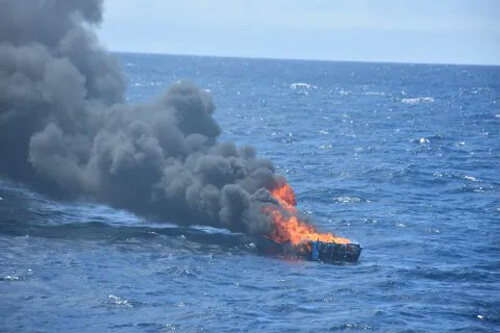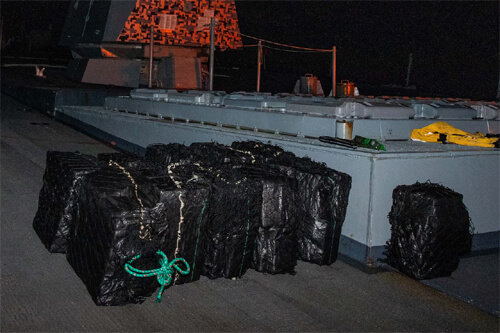Trump Administration Orders “Stop Work” on 80% Installed Offshore Wind Farm
In a surprising move on Friday, August 22, the Trump administration took action against an 80 percent installed offshore wind farm being built by Denmark’s Ørsted and a subsidiary of BlackRock. The Department of the Interior’s Bureau of Ocean Energy Management ordered a “halt to ongoing activities related to the Revolution Wind project on the outer continental shelf (OCS) to allow time for it to address concerns that have arisen.”
Unlike previous orders, which stopped projects before construction commenced, Revolution Wind has been under construction since 2024. Ørsted reports that the project is 80 percent complete, with all its offshore foundations installed and 45 out of 65 wind turbines installed. Steel in the water started in May 2024, and the first turbine installation was completed in September.
The company says Revolution Wind is employing hundreds of local union workers both on and offshore and that approximately two million labor union hours have been spent on the project. The shore operations are at ProvPort and Quonset in Rhode Island, and State Pier in New London, Connecticut.
BOEM was vague in its reasoning, writing in the letter to Ørsted North America that it is “seeking to address concerns related to the protection of national security interest of the United States and prevention of interference with reasonable uses of the exclusive economic zone, the high seas and the territorial seas.” The letter signed by Acting Director of BOEM Matthew Giacona also refers to “concerns that have arisen” during its review under the President’s Memorandum of January 20 which directed agencies to review the industry.
“Ørsted is evaluating all options to resolve the matter expeditiously,” the company said in a statement confirming it was complying and taking steps to stop offshore activities. “This includes engagement with relevant permitting agencies for any necessary clarification or resolution, as well as through potential legal proceedings, with the aim being to proceed with continued project construction towards COD in the second half of 2026.”
In its statement, the company notes the project spent more than nine years in review and is fully permitted. It received approval of its Construction and Operations Plan in November 2023.
Revolution Wind is located more than 15 miles south of Rhode Island and 32 miles southeast of Connecticut, with power contracts with both states. The nearest point of land is Martha’s Vineyard with the project approximately 12 miles southwest. Power was expected to start by the spring of 2026, and when the project is completed, it would generate a total of 704 MW, with 400 MW going to Rhode Island and 304 MW to Connecticut. Ørsted points out that the project is using the same turbine technology as South Fork Wind, which was completed as the first large, commercial offshore wind farm in the United States in 2024.
The stop work order pertains to all offshore activities on the OCS. The company can continue any emergency or safety work, as well as onshore activities. BOEM says the project may appeal this determination.
Ørsted said in its statement that it is considering “a range of scenarios, including legal proceedings.” The company is 50 percent owned by the Danish state, and just announced it was facing financial challenges due to the actions of the new U.S. government. It launched a rights offering to raise $9 billion from existing shareholders, which it is said is necessary to fund the construction work for another U.S. wind farm, Sunrise Wind, as well as completing Revolution Wind, after investors determined the risks are too great in the U.S. market based on the uncertainties raised by the Trump administration’s assault on wind energy.
Last year, Eversource sold its 50 percent interest in its partnership with Ørsted to Global Infrastructure Partners and its Skyborn Renewables fund. GIS was acquired last year by BlackRock to expand the group's investment in renewable energy and infrastructure, with BlackRock’s CEO, Larry Fink, reported to be a friend and supporter of Donald Trump.
This is the second time the administration has issued a stop work order on an offshore wind farm. In April, the Department of the Interior suspended licenses to Equinor just as offshore work was due to begin on the Empire Wind project off New York. The suspension lasted for a month and drew broad criticism, while there were reports of pressure, including from the Norwegian government, which owns Equinor. There were reports of a deal where New York State will permit an oil pipeline it was blocking in exchange for the lifting of the stop work order on Empire Wind. Equinor reported it would take a $1 billion impairment charge related to the impact of the U.S. actions on the project and the offshore wind industry.
Last week, the Trump administration also announced a further review of the manufacture of wind turbines and their components. Trump has repeatedly said they are made in China, although none of the U.S. projects are using Chinese turbines. The Commerce Department was ordered to start a trade investigation citing national security concerns over the importing of components for wind energy projects.
Experts point out that 40 percent of the components for wind energy projects come from Europe, while Mexico is supplying more than 30 percent of the material used in the construction. The Trump administration has said it will include aluminum and steel components for wind turbines in the 50 percent tariff on imports, and the new trade investigation could impose further tariffs on components. The administration has already suspended future licensing and revoked previous approvals. Trump has promised to “stop the windmills.”






